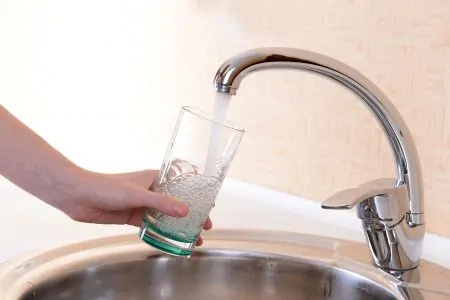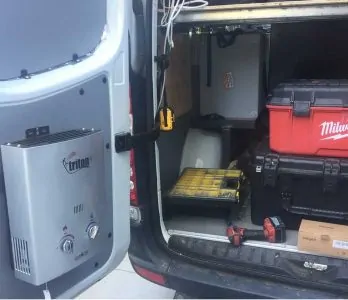Have you noticed that your water heater is becoming less efficient than it used to be? Perhaps the water is no longer as hot or flowing as well as it should. It’s possible that sediment has collected in the base of your water heater, impacting its efficiency.
You might also notice particles that resemble sand in your shower head or your faucet’s aerator. If you want to solve this issue without calling in a professional, you will need to flush your water heater.
In this article, we will explain how to spot sediment and, if you find it, how to get sediment out of a water heater. Knowing how to flush a water heater can prolong its lifespan and reduce your energy bills.
Key Takeaways
- Signs of sediment build-up include sand-like deposits, unusual noises, and reduced water flow.
- Flush your water heater by turning off the power and water supply, draining the system, and refilling it.
- Regularly flushing your water heater can prolong its lifespan and reduce energy bills.
- Always prioritize safety when performing home maintenance tasks, and call a professional if needed.
Is There Sediment in My Water Heater?
If you have never flushed your water heater before, it’s likely that there is at least some sediment build-up at the bottom of it. Most manufacturers recommend flushing a heater about every six months (1). Here are a few telltale signs of water heater sediment build-up:
- Sand-like deposits: When water is heated, calcium and magnesium in the water solidifies and forms a white or tan-colored deposit (2). This gradually builds up at the bottom of your water heater and can spread through the pipes to your faucet.
- Noises: If your water heater is making unusual noises, it probably needs some TLC. A rumbling noise might be heard as water heats and expands through the sediment. Alternatively, you might hear a popping noise as bubbles form and break through this build-up. Sizzling, cracking, and hissing from a buried heating element are also possible.
- Water flow: You might notice that your water doesn’t flow quite as well as it did or that it is not as hot. Again this is usually caused by a build-up of sediment blocking its flow and hindering the heating element’s function.
Let’s look at how to rectify this issue.
How to Flush a Water Heater
To accomplish this, you first need to know where your power source is. This means the fuse box for an electric heater and the gas supply tap for a gas heater. You will also need a garden hose and a bucket.
1. Turning Off the Power
Gas Water Heater
For a gas water heater, some recommend turning the thermostat to “pilot” while others recommend turning off the gas supply to the boiler.
To turn to pilot:
- Locate the water heater thermostat. This is usually on the side of the appliance.
- You should see three options: on, pilot, and off.
- Turn the dial to pilot.
To turn off the gas supply:
- Locate the thermostat and turn the dial to off.
- Follow the gas pipe to the thermostat and find the lever that turns the gas on and off.
- This is usually parallel with the pipe when it’s on and at a 90-degree angle when off.
- Turn the gas supply off.
Electric Water Heater
For an electric water heater, you will need to locate the fuse box or circuit breaker box. It’s usually a grey box with a hinged door and has either switches or fuses (glass-topped shapes or small cylinders with metal ends) inside. It might be in your garage, basement, or on a wall outside your home.
To Turn Off the Power Supply From a Circuit Breaker Box
- Inside the box, there are small on and off switches. These each break the circuit for a branch of the power in your home. If you know which branch your water heater is on, turn that individual switch off.
- If you don’t know which switch breaks the power for the circuit your water heater is on, look for a switch labeled “Main”. This is usually a larger switch located above or to the side of the individual circuit breakers.
- Turn this switch off. Be aware that this will cut the power to your entire home.
To Turn Off the Power Supply from a Fuse Box
- If you have fuses instead of breaker switches, you will need to locate the fuse that powers your water heater.
- Unscrew this fuse if you know which one it is.
- If you’re unsure, above or to the side of the fuses you should see a box with a lever or handle.
- Move this handle or lever to the indicated “off” position. This will cut power to the entire home.
2. Turning Off the Water Supply
Once the power to your water heater has been turned off, you need to turn off the water supply. The valve that does this can usually be found on the cold water inlet pipe located at the top of the water heater.
There are two types of valves you might encounter: a ball valve or a gate valve.
The ball valve will have a lever that you turn 90 degrees to stop the cold water supply.
A gate valve has a handle or knob that you turn until it stops.
3. Flushing the System
Now that your power and water are turned off, you can begin flushing your water heater (3). To avoid accidents with hot water, it’s a good idea to turn the heat down the night before.
It’s now time to flush the system. To do this:
- Open a hot water faucet in a sink or tub in your home. This prevents a vacuum from being created, which can trap water.
- Locate the drain valve or drain cock, normally found at the base of your water heater.
- Attach your garden hose to the drain cock or valve. If you don’t have a hose, you can always use a drain pan to catch the water, but be careful if it’s hot. Run the end of your hose to a drain or out to your driveway. If your water heater is in your basement with no floor drain available, you might need a portable water pump.
- If you’re draining hot water, make sure your hoses and buckets are good quality and won’t soften or get too hot. Cover the hose connection and drain cock with a rag or towel to prevent water spraying if there is a pressure leak.
- Open the drain cock to allow the water to flow from the heater.
- Fill a test bucket with water during the draining process and allow it to stand for a few minutes. If you see sediment in the bottom, continue flushing. You ideally want to flush the heater until the water runs clear.
- If the tank is empty but you still think there might be sediment in it, turn the cold water back on. Allow the tank to partially fill and then drain it again. You might need to do this a few times until little or no sediment comes out.
- Keep draining until the water runs clear with no sediment.
Things to Consider
There are a few things you need to keep in mind when draining the water heater.
- You might want to open the pressure relief valve. There will be a pipe coming from this valve so make sure you put a bucket underneath it to catch the water. If no water flows when you open this valve, it could be faulty and need replacing.
- If you let the heater cool overnight, you could use this water to clean your yard or water your plants. Remember that it will have sediment in it, so don’t use it on delicate plants and definitely don’t use it to wash your car. This is a great way to save some water while flushing your heater.
- Always exercise caution if the water is hot.
- The drain cock on your heater might be old or it could be made from plastic. Be careful not to force it and potentially break it. This would mean calling out a professional and a costly repair.
4. Refilling and Turning Water Heater Back On
It’s time to get your system working to provide you with hot water again. Start by closing the drain cock and removing your garden hose. If you previously opened the pressure release valve, close it.
Turn off the faucet that you opened at the beginning of this process.
Now, turn on your water supply and let the water heater fill again. Once it’s full, you can open the pressure release valve slowly to let any excess air escape. Close it again once the air is gone.
Open a hot water faucet again and let any trapped air work its way out. Once the water is flowing freely, turn it off. Remember that it will be cold water coming from the faucet at this stage.
Your water heater is now full and the air has been bled from the system, so it’s time to restore the power. Turn on the electricity at the fuse or breaker box, or restore the gas supply.
If you turned the gas off, you will need to relight the pilot light and turn the dial on the tank to “on”. If you only turned the dial to pilot, turn it back on.
After about 20 minutes, you should have hot water flowing from your faucet again. If so, you have successfully flushed your water heater.
My Water Heater is Old, Will Flushing It Still Work?
The life expectancy of a water heater is generally between 10 and 13 years (4). One issue you might encounter with an older water heater is valves that won’t open. If you’re ever in doubt, it’s a good idea to call in a professional.
How Can I Prolong My Water Heater’s Life?
Each manufacturer’s recommendations differ with regard to maintenance. However, there are a few basic things you can do to keep your hot water supply flowing.
These include flushing the water heater on a regular basis, every three to six months. The pressure release valve and anode rod should also be checked every six months. In reality, the anode rod will probably only need changing every three to four years (5).
The pressure release valve is a built-in safety feature that automatically opens and releases pressure if too much builds up in the heater. When this doesn’t work properly, the tank can over-pressurize and explode.
We mentioned checking it as part of the flushing process, but here’s how to do it separately.
- Turn off the power supply to your water heater or turn your gas switch to pilot mode.
- Shut off the cold water supply to the water heater.
- Place a bucket under the hose from the pressure release valve.
- Open the trip lever on the valve.
- You should see some water and vapor or hear a slight rush of air.
- If you don’t hear or see anything, the valve might be faulty and need replacing.
Safety First
Keep in mind that with any home maintenance, safety must come first. If you don’t feel confident enough to carry out maintenance such as flushing a water heater yourself, call a professional instead.
When doing it yourself, wear goggles, gloves, and protective clothing. This is especially important if you don’t let the water cool before draining it. Hot water and steam can scald and cause injury.











